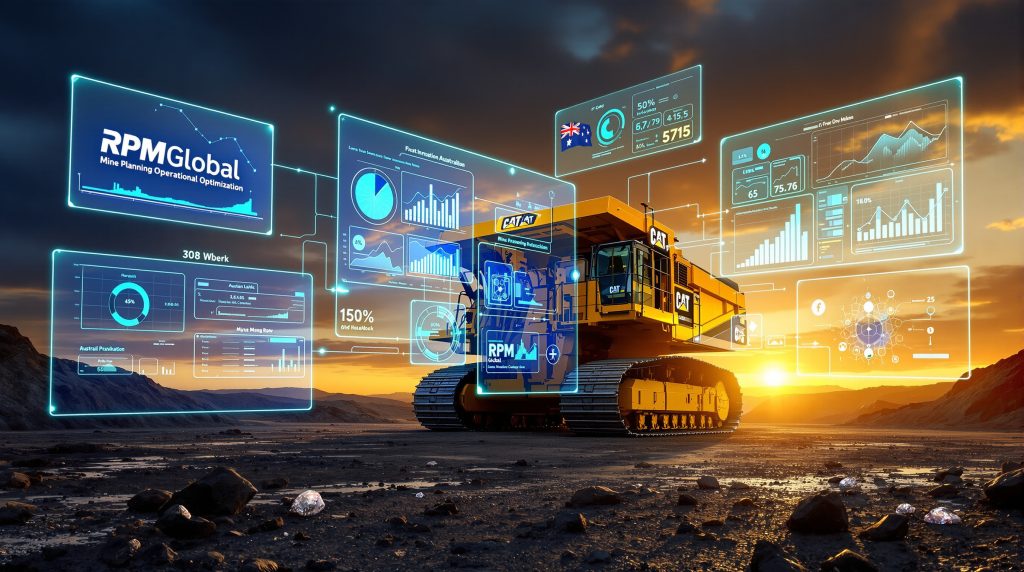Caterpillar's RPMGlobal Acquisition: Mining Technology Consolidation Trends
What Is Driving Caterpillar's Interest in RPMGlobal?
Caterpillar, the world's leading mining equipment manufacturer, has made a strategic move in the mining technology sector with a non-binding acquisition offer for RPMGlobal. This bid values the mining software provider at approximately A$1.12 billion (A$5 per share), representing a 32.6% premium over RPMGlobal's previous closing price. The Caterpillar acquisition of RPMGlobal signals a fundamental shift in how major equipment manufacturers view software integration within their business models.
The substantial premium offered by Caterpillar highlights the growing recognition that digital transformation is becoming equally important as physical machinery in the mining industry. According to McKinsey Global Institute's report on digital transformation in mining, companies are increasingly prioritizing technological solutions to improve operational efficiency and meet ESG requirements.
RPMGlobal's specialized software solutions for mine planning, scheduling, and operational optimization complement Caterpillar's existing hardware-focused portfolio. This strategic combination aims to create an integrated ecosystem of physical and digital mining solutions that addresses the full spectrum of mining operational needs.
Understanding the Acquisition Structure and Terms
Deal Framework and Current Status
The proposed transaction is structured as an all-cash offer through a scheme of arrangement, a common approach for friendly acquisitions in Australia. Key elements of the deal include:
- Non-binding indicative offer of A$5 per share
- Total valuation of approximately A$1.12 billion
- Premium of 32.6% over RPMGlobal's last trading price
- Exclusivity agreement granted by RPMGlobal's board
The non-binding nature of the offer means Caterpillar retains flexibility to adjust terms or withdraw based on findings during due diligence. Under Australian Corporations Act 2001, the scheme of arrangement structure requires 75% shareholder approval and court approval to proceed.
RPMGlobal's board has signaled preliminary support for the proposal, subject to satisfactory completion of due diligence and absence of superior competing offers. This conditional backing could change if Caterpillar's stance shifts during the investigation process.
Market Response and Shareholder Implications
The market reacted positively to the announcement, with RPMGlobal's share price jumping approximately 20-24% in subsequent trading sessions. This immediate price movement reflects investor confidence in the deal's potential completion, though the gap between current trading prices and the full offer price indicates some remaining uncertainty about execution.
For existing shareholders, the premium represents significant value creation, particularly for those who invested when the company traded at lower multiples. However, new investors entering at current prices face a narrower upside with elevated risk if the deal fails to materialize.
The average daily trading volume for RPMGlobal prior to the announcement was approximately 500,000 shares, according to ASX market data. This relatively modest liquidity profile means large institutional investors may face challenges in building or exiting positions without market impact.
Why RPMGlobal's Business Model Appeals to Caterpillar
Recurring Revenue and Financial Stability
RPMGlobal presents an attractive acquisition target primarily due to its robust financial profile:
| Financial Metric | Value | Strategic Significance |
|---|---|---|
| Annual Recurring Revenue (FY25) | A$71.8 million | Predictable income stream |
| Multi-year Contract Backlog | A$200 million | Long-term revenue visibility |
| Implied ARR Multiple | 14.6× | Premium valuation for software capabilities |
| Typical Software Gross Margins | 70-85% | Higher profitability than equipment (15-25%) |
This financial structure provides Caterpillar with predictable, high-margin revenue streams that can help smooth out the cyclical nature of equipment sales. According to PwC's Industrial Manufacturing Outlook 2024, recurring revenue models provide earnings stability that offsets cyclical equipment sales volatility.
The substantial backlog of contracted revenue represents guaranteed future income, reducing earnings volatility and providing greater visibility for financial planning and investor relations.
Software Integration and Competitive Advantage
Beyond financial metrics, RPMGlobal's software suite offers Caterpillar several strategic advantages:
- Customer relationship enhancement – Software creates ongoing touchpoints with mining clients
- Data-driven insights – Access to operational data across mining sites
- Ecosystem development – Potential to create an integrated hardware-software platform
- Differentiation from competitors – Moving beyond traditional equipment manufacturing
Boston Consulting Group's research on "The Future of Industrial Software" highlights that integrated software-hardware platforms create customer switching costs and enhance competitive moats. By acquiring these capabilities, Caterpillar positions itself to capture more value throughout the mining value chain, rather than focusing solely on equipment sales and maintenance.
Industry Context: Mining Technology Consolidation Trends
Digital Transformation in Mining Operations
The mining industry is undergoing rapid digital transformation, driven by several factors:
- Increasing pressure to improve operational efficiency
- Growing emphasis on sustainability and emissions reduction
- Need for enhanced safety through automation and remote operations
- Rising complexity of mining operations requiring sophisticated planning tools
These trends have elevated the importance of software solutions from supplementary tools to mission-critical systems. According to Ernst & Young's Global Mining & Metals Digital Survey 2024, the mining industry spent approximately $5.1 billion on data-driven mining operations in 2023, up 12% from the previous year.
Mining companies increasingly view digital capabilities as essential for maintaining competitiveness and meeting regulatory requirements. The global mining software market was valued at approximately $18.1 billion in 2023 and is expected to reach $29.1 billion by 2030, according to Grand View Research's Mining Software Market Report.
Potential for Broader M&A Activity
Caterpillar's move may signal the beginning of a consolidation wave in mining technology. Several factors support this potential trend:
- Strategic imperative – Major equipment manufacturers need digital capabilities
- Valuation disparities – Mining tech firms often trade at discounts to broader tech sector
- Integration benefits – Combined hardware-software offerings create ecosystem advantages
- Global competition – Pressure to secure strategic assets before competitors
Historical precedents support this view. Komatsu's acquisition of Modular Mining Systems in 2008 for $380 million demonstrated early recognition of software value in mining equipment. Similarly, Hexagon AB's acquisition of Leica Geosystems Mining division for $2.1 billion in 2017 represented a major consolidation in the mining technology space.
Other major mining equipment manufacturers like Komatsu, Sandvik, and Epiroc may feel compelled to make similar acquisitions to maintain competitive positioning. This could create acquisition interest in other specialized mining software and technology providers, potentially including ASX-listed companies like Imdex Limited, Boart Longyear, and MinRes technology divisions.
How Does This Valuation Compare to Industry Standards?
Valuation Metrics and Comparisons
The A$1.12 billion valuation represents significant premiums across various metrics:
- 14.6× Annual Recurring Revenue
- 32.6% premium to last closing share price
- Substantial premium to most analyst price targets
This valuation framework reflects the strategic importance Caterpillar places on software capabilities rather than traditional mining services multiples. While conventional mining services companies typically trade at Enterprise Value/Revenue multiples of 1-3×, software businesses with recurring revenue models command premium valuations due to their predictability and scalability.
According to SaaS Capital Market Report 2024, typical SaaS company ARR multiples range from 5×-20× depending on growth rates. Industrial software companies average 8×-12× revenue multiples, based on Software Equity Group benchmarking data. RPMGlobal's valuation sits at the higher end of this range, reflecting both its strategic value and Caterpillar's strong interest.
Setting New Benchmarks for Mining Technology
If completed, this transaction could establish new valuation benchmarks for mining technology companies. The premium multiple suggests that major industrial players may value mining software assets more highly than the public markets currently do, potentially leading to revaluation of similar companies.
The valuation also reflects Caterpillar's assessment of synergy potential and strategic fit, rather than standalone financial metrics alone. This integrated view of value could influence how other potential acquirers approach mining technology targets, potentially driving up acquisition premiums across the sector.
What Are the Key Risks to Deal Completion?
Due Diligence and Execution Challenges
Several factors could potentially derail the acquisition:
- Due diligence findings – Unexpected issues in technology, contracts, or financials
- Integration complexity – Challenges in combining different corporate cultures and systems
- Competitive response – Potential competing bids from other strategic buyers
- Market conditions – Changes in broader economic environment affecting deal rationale
The non-binding nature of the current offer means Caterpillar can adjust terms or withdraw if these issues arise during the due diligence process. Integration risks are particularly high for software acquisitions due to cultural and technical differences between traditional manufacturing companies and software developers.
Regulatory Considerations
Regulatory approval represents another potential hurdle:
- Foreign investment review – Australia's Foreign Investment Review Board (FIRB) must approve the transaction
- Competition concerns – Potential scrutiny of market concentration in mining technology
- Data sovereignty issues – Increasing sensitivity around cross-border data transfers
FIRB approval timeline typically spans 30-90 days for standard cases, according to Australian Treasury statistics. While preliminary indications suggest U.S. regulatory clearance may be forthcoming, the Australian review process remains a key milestone for deal completion.
The scheme of arrangement success rate in Australia is approximately 95% when recommended by the target company board, according to ASX statistics. However, regulatory complications could extend timelines or impose conditions that affect deal value.
Strategic Implications for the Mining Industry
Evolution of Mining Equipment Providers
Caterpillar's bid for RPMGlobal reflects a fundamental shift in how equipment manufacturers position themselves:
- From hardware providers to integrated solution providers
- From transactional relationships to ongoing partnerships
- From selling products to enabling outcomes
According to Accenture's industrial equipment research, mining equipment manufacturers are increasingly shifting from product sales to outcome-based service models. This evolution mirrors trends in other industrial sectors where AI in mining operations increasingly drive competitive differentiation and customer value.
Deloitte Insights' research on industrial automation trends notes that software integration creates competitive differentiation in industrial equipment markets. This strategic repositioning could reshape competitive dynamics across the mining equipment sector.
Impact on Mining Operations and Productivity
The integration of equipment and software under unified providers could accelerate several industry trends:
- Faster implementation of automation technologies
- More seamless data flows between planning and execution systems
- Enhanced predictive maintenance capabilities
- Improved optimization across entire mining value chains
MIT Technology Review highlights that digital twins and predictive analytics are becoming standard requirements in mining operations. Mining companies may benefit from these integrated solutions while potentially facing reduced flexibility in mixing technologies from different providers.
This consolidation could also impact procurement strategies at major mining companies, potentially shifting from best-of-breed approaches to more integrated solution suites that offer enhanced interoperability.
What Should Investors Watch for Next?
Key Milestones and Decision Points
Investors should monitor several upcoming developments:
- Completion of due diligence – Expected timeline and any extensions
- Binding offer announcement – Transition from indicative to firm commitment
- Regulatory filings and approvals – Particularly FIRB in Australia
- Shareholder vote – Required under the scheme of arrangement structure
- Competing bids – Potential for other strategic buyers to emerge
The average time from announcement to completion for Australian schemes is 4-6 months, according to Australian M&A statistics. The shareholder meeting is typically scheduled 2-3 months after scheme booklet dispatch, providing a critical timeline for investment decisions.
The transaction timeline likely extends several months, with multiple decision points that could affect the outcome. Trading halt protocols and price discovery mechanisms during the scheme process will influence short-term price movements.
Broader Market Implications
Beyond this specific transaction, investors should consider:
- Potential revaluation of other mining technology companies
- Strategic responses from Caterpillar's competitors
- Changing expectations for mining company technology investments
- Emergence of new acquisition targets in adjacent technology areas
This deal may serve as a catalyst for broader reassessment of how mining technology companies are valued and positioned in the market. Investors with exposure to the mining technology sector should review their portfolios to identify potential acquisition candidates with similar characteristics to RPMGlobal.
How Might This Affect Other Mining Technology Providers?
Potential Targets for Future Acquisitions
The Caterpillar-RPMGlobal transaction could highlight the strategic value of other specialized mining technology providers, particularly those with:
- Established recurring revenue models
- Proprietary algorithms or methodologies
- Strong customer relationships with major mining companies
- Complementary capabilities to equipment manufacturers
Companies offering solutions in mine planning, fleet management, predictive maintenance, and ESG reporting may attract particular interest from strategic acquirers. Venture capital investment in mining technology startups has also accelerated, creating a pipeline of potential acquisition targets at various stages of development.
The automation and digitalization investments in the mining sector are expected to reach $8.2 billion by 2027, according to McKinsey Global Institute. This substantial growth trajectory creates opportunities for software providers that can address key operational challenges.
Competitive Dynamics and Market Positioning
Existing mining technology providers may need to reassess their strategic positioning:
- Independence vs. partnership – Balancing standalone growth with strategic alliances
- Product specialization vs. platform approach – Focusing on niche excellence or broader solutions
- Geographic expansion – Securing global footprint before consolidation accelerates
- Investment priorities – Balancing growth with profitability to maximize strategic value
The competitive landscape may shift rapidly as major players secure strategic assets and reposition their offerings. Companies that successfully differentiate through technological innovation or domain expertise may command premium valuations in future acquisition scenarios.
Sandvik's digital initiatives have contributed to double-digit growth in their software revenue streams, according to their 2023 Annual Report. This success may motivate other equipment manufacturers to pursue similar strategies through acquisition rather than organic development.
FAQ: Key Questions About the Caterpillar-RPMGlobal Deal
What exactly is Caterpillar offering for RPMGlobal?
Caterpillar has made a non-binding indicative offer of A$5 per share in cash, valuing RPMGlobal at approximately A$1.12 billion. This represents a 32.6% premium to RPMGlobal's last closing price before the announcement.
Why is RPMGlobal attractive to Caterpillar?
RPMGlobal offers Caterpillar access to specialized mining software with A$71.8 million in annual recurring revenue and A$200 million in contracted future revenue. This provides predictable income streams and enhances Caterpillar's ability to offer integrated mining solutions.
Has RPMGlobal's board supported the offer?
The board has granted exclusivity to Caterpillar and indicated preliminary support, subject to satisfactory due diligence outcomes and the absence of superior proposals. Final approval would require formal board recommendation and shareholder approval.
What happens if the deal falls through?
If Caterpillar withdraws its offer or the transaction fails to receive necessary approvals, RPMGlobal's share price could potentially revert toward pre-announcement levels, as most analyst valuations were below the A$5 offer price.
Could this acquisition trigger more M&A activity in mining technology?
Yes, this transaction could potentially spark increased acquisition interest in mining technology companies, as major equipment manufacturers and industrial conglomerates recognize the strategic importance of digital capabilities in the mining sector.
The Future of Mining Technology Integration
Caterpillar's bid for RPMGlobal represents more than just a significant premium for shareholders—it signals a fundamental shift in how the mining industry values technology integration. By combining physical equipment expertise with advanced software capabilities, Caterpillar aims to create a more comprehensive offering that addresses the full spectrum of mining operational needs.
For investors, this transaction highlights the strategic value of specialized mining technology providers that may have previously been underappreciated by the market. The premium valuation suggests that major industrial players see significant long-term value in securing these capabilities, potentially setting the stage for further mining consolidation trends.
As the mining industry continues its digital transformation journey, the companies that successfully integrate hardware and software solutions will likely emerge as the dominant players. The Caterpillar acquisition of RPMGlobal may well be remembered as a pivotal moment in this evolution—the point where mining equipment manufacturers fully embraced their future as technology companies.
Readers interested in learning more about mining evolution trends and reclamation innovation insights can also explore related educational content at Stocks Down Under, which offers additional perspectives on mining technology developments and industry analysis.
Want to Spot the Next Major Mining Discovery Before the Market?
Discovery Alert's proprietary Discovery IQ model instantly notifies investors about significant ASX mineral discoveries, providing a crucial edge for both short-term traders and long-term investors. Explore historic returns from major discoveries and begin your 30-day free trial at Discovery Alert's discoveries page.




